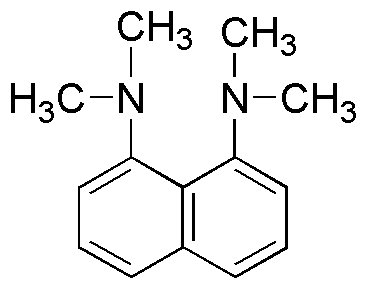1,8-Bis(dimethylamino)naphthalene is widely utilized in research focused on:
- Fluorescent Dyes: This compound serves as a key component in the development of fluorescent dyes used in biological imaging, enabling researchers to visualize cellular processes with high precision.
- Organic Electronics: It is employed in the manufacturing of organic light-emitting diodes (OLEDs), providing improved efficiency and color purity compared to traditional materials.
- Chemical Sensors: The compound is used in the formulation of chemical sensors, particularly for detecting environmental pollutants, offering a sensitive and selective response.
- Polymer Chemistry: It acts as a building block in synthesizing advanced polymers, enhancing properties such as conductivity and thermal stability for applications in various industries.
- Pharmaceuticals: This chemical is investigated for its potential in drug development, particularly in targeting specific biological pathways, which may lead to more effective treatments with fewer side effects.
General Information
Properties
Safety and Regulations
Applications
1,8-Bis(dimethylamino)naphthalene is widely utilized in research focused on:
- Fluorescent Dyes: This compound serves as a key component in the development of fluorescent dyes used in biological imaging, enabling researchers to visualize cellular processes with high precision.
- Organic Electronics: It is employed in the manufacturing of organic light-emitting diodes (OLEDs), providing improved efficiency and color purity compared to traditional materials.
- Chemical Sensors: The compound is used in the formulation of chemical sensors, particularly for detecting environmental pollutants, offering a sensitive and selective response.
- Polymer Chemistry: It acts as a building block in synthesizing advanced polymers, enhancing properties such as conductivity and thermal stability for applications in various industries.
- Pharmaceuticals: This chemical is investigated for its potential in drug development, particularly in targeting specific biological pathways, which may lead to more effective treatments with fewer side effects.
Documents
Safety Data Sheets (SDS)
The SDS provides comprehensive safety information on handling, storage, and disposal of the product.
Product Specification (PS)
The PS provides a comprehensive breakdown of the product’s properties, including chemical composition, physical state, purity, and storage requirements. It also details acceptable quality ranges and the product's intended applications.
Certificates of Analysis (COA)
Search for Certificates of Analysis (COA) by entering the products Lot Number. Lot and Batch Numbers can be found on a product’s label following the words ‘Lot’ or ‘Batch’.
*Catalog Number
*Lot Number
Certificates Of Origin (COO)
This COO confirms the country where the product was manufactured, and also details the materials and components used in it and whether it is derived from natural, synthetic, or other specific sources. This certificate may be required for customs, trade, and regulatory compliance.
*Catalog Number
*Lot Number
Safety Data Sheets (SDS)
The SDS provides comprehensive safety information on handling, storage, and disposal of the product.
DownloadProduct Specification (PS)
The PS provides a comprehensive breakdown of the product’s properties, including chemical composition, physical state, purity, and storage requirements. It also details acceptable quality ranges and the product's intended applications.
DownloadCertificates of Analysis (COA)
Search for Certificates of Analysis (COA) by entering the products Lot Number. Lot and Batch Numbers can be found on a product’s label following the words ‘Lot’ or ‘Batch’.
*Catalog Number
*Lot Number
Certificates Of Origin (COO)
This COO confirms the country where the product was manufactured, and also details the materials and components used in it and whether it is derived from natural, synthetic, or other specific sources. This certificate may be required for customs, trade, and regulatory compliance.


